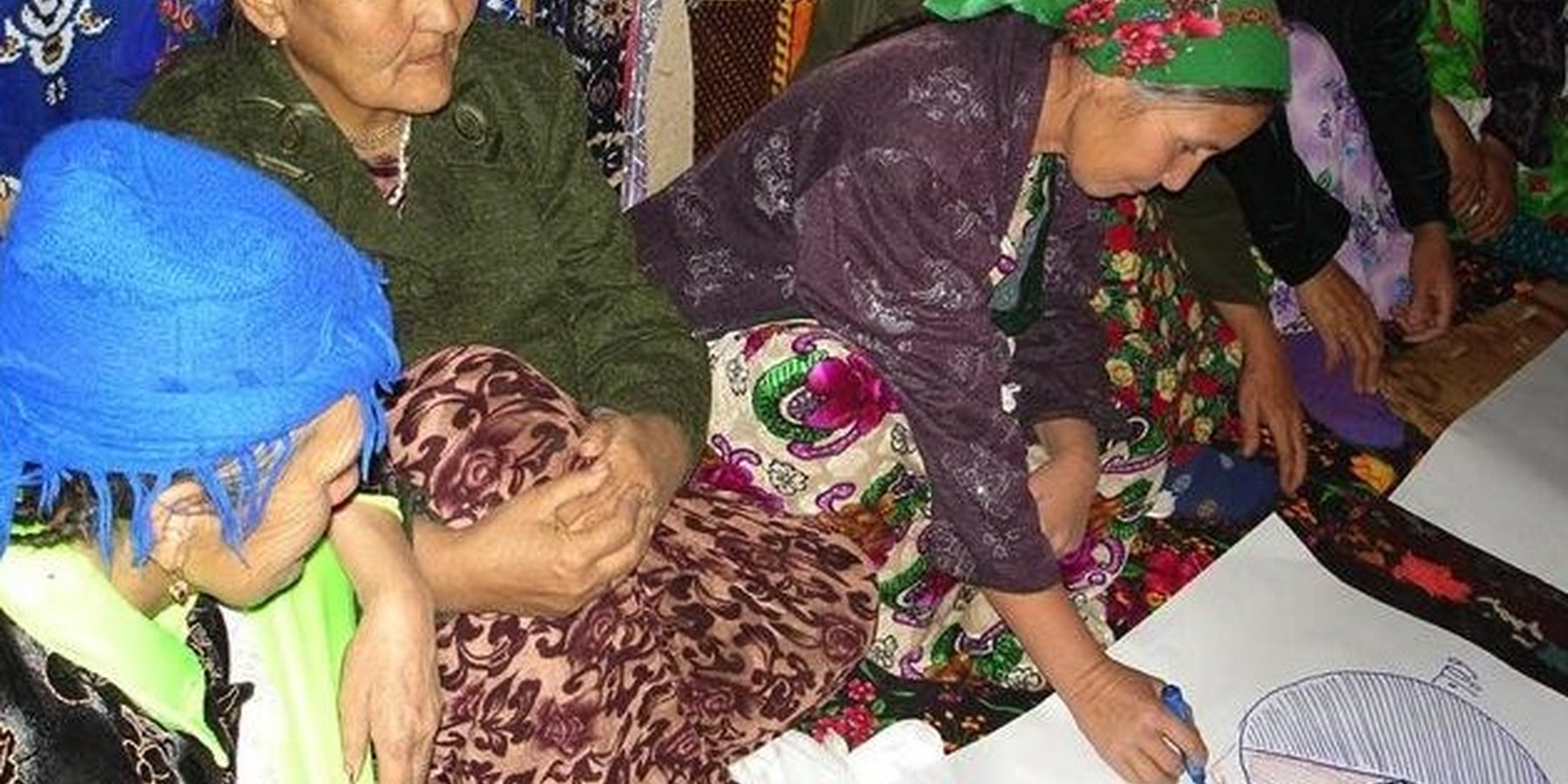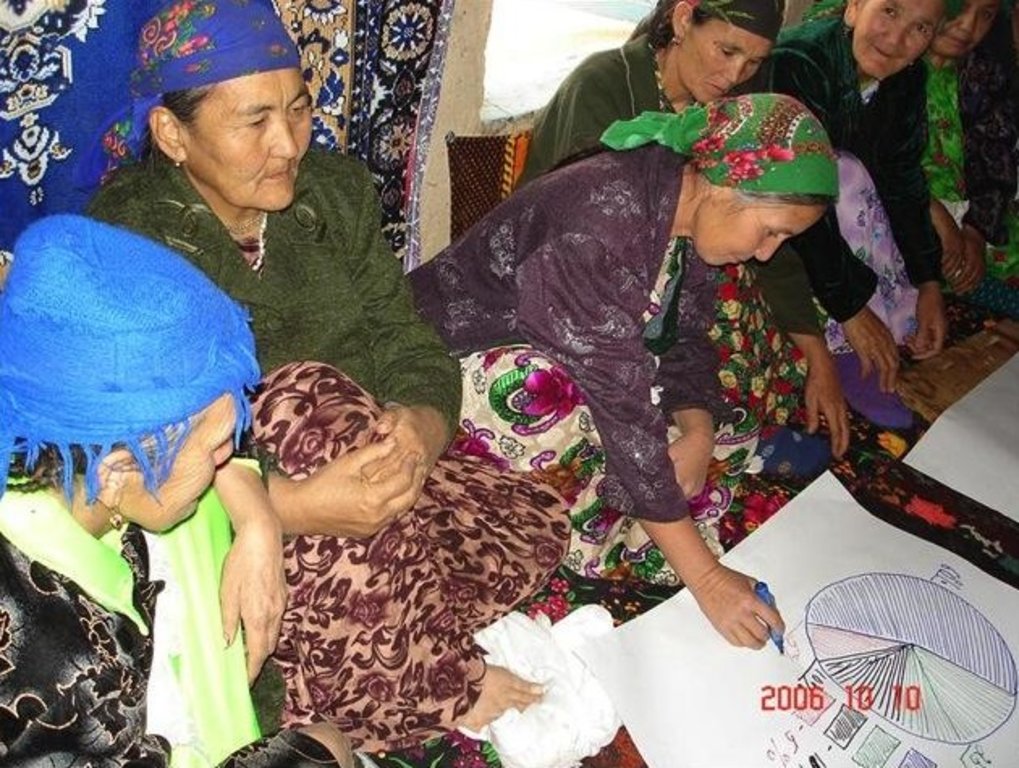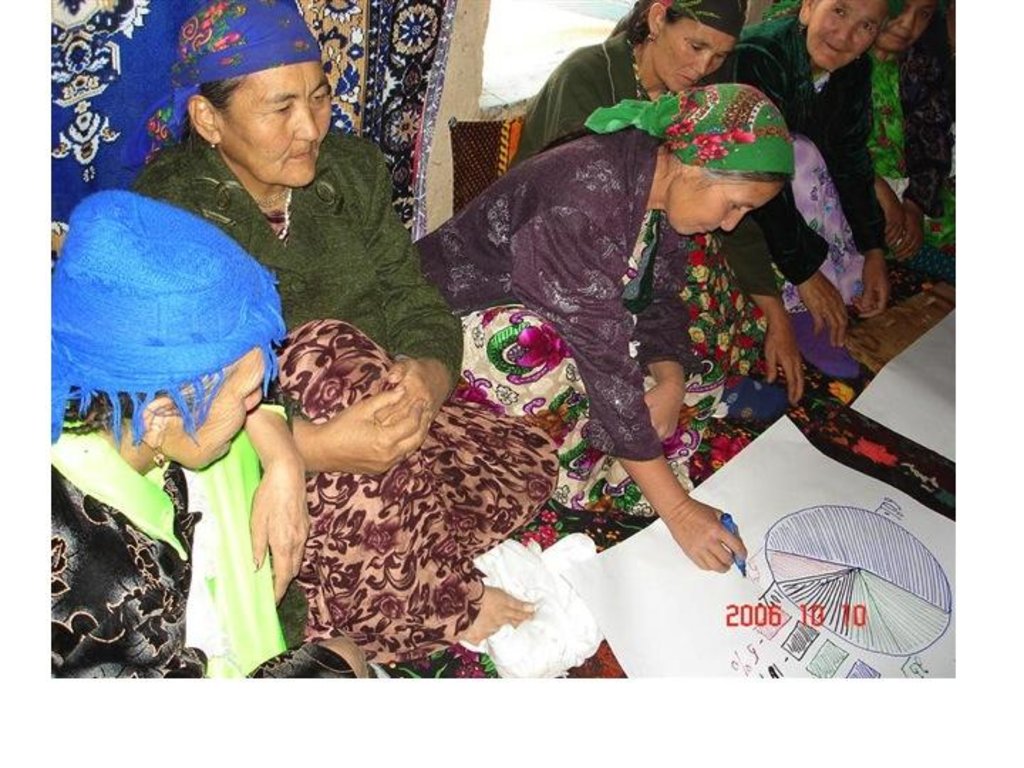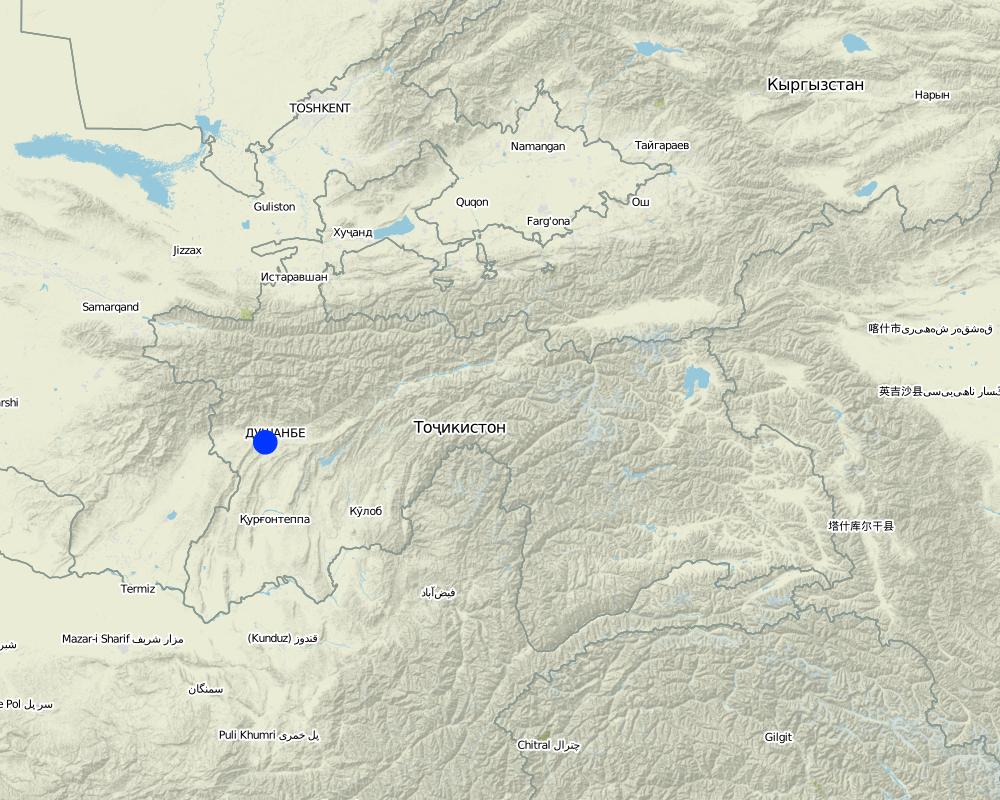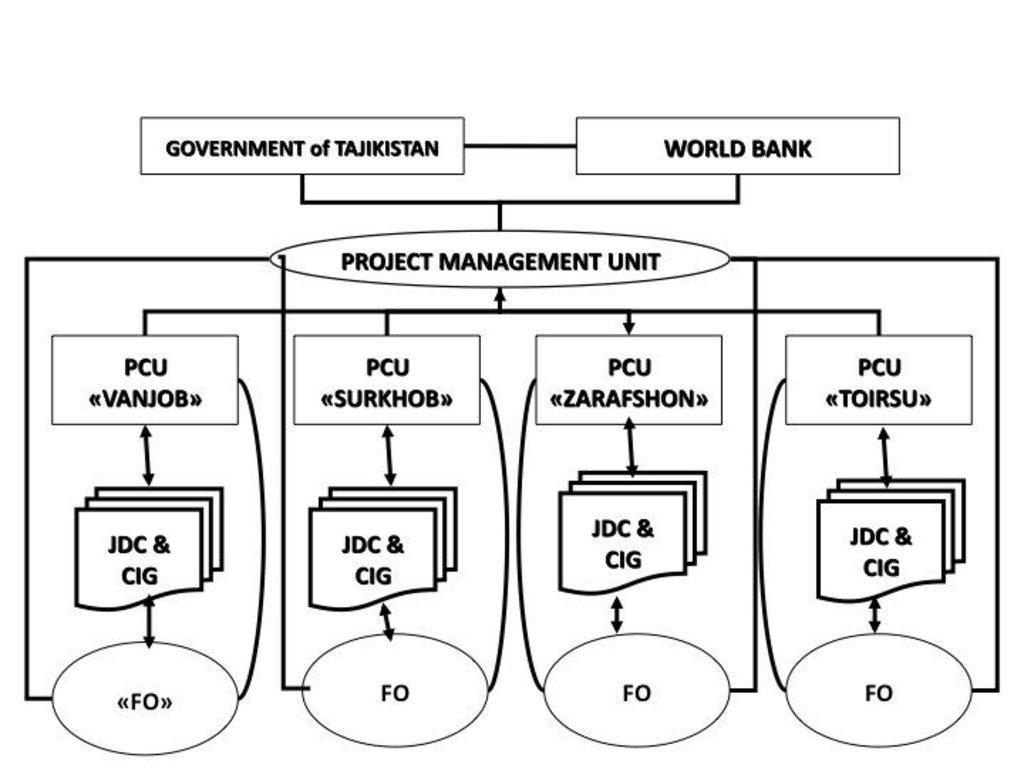Village-level participatory planning for sustainable agriculture and land management [ทาจิกิสถาน]
- ผู้สร้างสรรค์:
- การอัพเดท:
- ผู้รวบรวม: Nandita Jain
- ผู้เรียบเรียง: –
- ผู้ตรวจสอบ: David Streiff
approaches_2447 - ทาจิกิสถาน
- บทสรุปทั้งหมดในรูปแบบของ PDF
- บทสรุปทั้งหมดในรูปแบบของ PDF เพื่อพิมพ์
- บทสรุปทั้งหมดในรูปหน้าเว็บ
- บทสรุปทั้งหมด (ไม่มีการจัดเรียง)
- Village-level participatory planning for sustainable agriculture and land management: 2 พฤศจิกายน 2021 (public)
- Village-level participatory planning for sustainable agriculture and land management : 10 สิงหาคม 2017 (inactive)
- Village-level participatory planning for sustainable agriculture and land management : 7 กรกฎาคม 2017 (inactive)
- Village-level participatory planning for sustainable agriculture and land management : 7 กรกฎาคม 2017 (inactive)
ดูส่วนย่อย
ขยายทั้งหมด ย่อทั้งหมด1. ข้อมูลทั่วไป
1.2 รายละเอียดที่ติดต่อได้ของผู้รวบรวมและองค์กรที่เกี่ยวข้องในการประเมินและการจัดเตรียมทำเอกสารของแนวทาง
ผู้เชี่ยวชาญ SLM:
Mott Jessica
World Bank
สหรัฐอเมริกา
ชื่อของโครงการซึ่งอำนวยความสะดวกในการทำเอกสารหรือการประเมินแนวทาง (ถ้าเกี่ยวข้อง)
World Bank (World Bank) - สหรัฐอเมริกา1.3 เงื่อนไขที่เกี่ยวข้องกับการใช้ข้อมูลที่ได้บันทึกไว้ผ่านทาง WOCAT
วันที่เก็บรวบรวมข้อมูล (ภาคสนาม):
10/10/2016
ผู้รวบรวมและวิทยากรหลักยอมรับเงื่อนไขเกี่ยวกับการใช้ข้อมูลที่ถูกบันทึกผ่านทาง WOCAT:
ใช่
2. คำอธิบายของแนวทาง SLM
2.1 การอธิบายแบบสั้น ๆ ของแนวทาง
Design and implementation of participatory planning for village-level sustainable agriculture and land management investments through small grants for groups of upland farmers.
2.2 การอธิบายอย่างละเอียดของแนวทาง
การอธิบายอย่างละเอียดของแนวทาง:
Aims / objectives: As part of the CAWMP, participatory planning aimed to generate village-based community action plans (CAPs) that identified priority investments and beneficiaries for small grants to sustainably increase rural production. A total of 402 three-year plans were developed, through which about 4000 investments in four upland project sites were funded that resulted in increased livelihood assets for over 43,000 households and more than 96,000ha under improved land management practices.
Methods: Under supervision of a government-appointed Project Management Unit (PMU), four international facilitating organizations (FOs) were contracted to work closely with local field coordination units and Jamoat (“sub-district”) Development Committees (JDCs). An operational manual laid out guidelines for developing CAPs and the management of rural production investments. Activities could be proposed for three types of investment that would increase/improve: a) farm productivity, b) land resource management and c) small-scale infrastructure to support rural production. CAPs were required to include: (i) identifiers such as a location map, numbers of beneficiaries, area covered; (ii) an indicative list of investments and associated Common Interest Groups (CIGs) by investment type and cost; (iii) estimate of labor and materials needed; (iv) estimates of beneficiary contribution for each investment and (v) list of beneficiaries resulting from the improvements, and (vi) signed agreements to participate in the cost sharing, labor provision and subsequent operation and maintenance. Within each village, fixed amounts of funding were available and were exceeded by the value of proposed investments. Thus villagers considered the available budget, number of beneficiaries and associated risks when selecting investments (see TAJ044 for details). A beneficiary contribution of at least 25% of the value of the grant was required. In some cases, FOs and JDCs obtained other financing for activities outside of CAWMP.
Stages of implementation: Key steps in the implementation included: 1) Training of facilitators in participatory planning 2) Open village assembly introducing CAWMP and the CAP guidelines; 3) Participatory rural appraisals (PRA); 4) Sharing of findings in village assembly and identification of potential rural investments; 5) Prioritizing proposals and formation of CIGs; 6) Circulation of CAP, e.g., public display in JDC offices; 7) Preparation and submission of rural investment proposals with assistance from FOs and PCUs to JDCs/JRCs for initial screening and approval; and 8) Periodic meetings to review CAPs.
Role of stakeholders: Within villages, vulnerable households were identified and appraised through the use of PRA tools, such as wealth ranking and villager consultations and often were selected as priority recipients of initial investments. During the course of the project, environmental appraisal aspects of the planning process were strengthened through additional training in tools for participatory analysis.
2.3 รูปภาพของแนวทาง
2.5 ประเทศ ภูมิภาค หรือสถานที่ตั้งที่ได้นำแนวทางไปใช้
ประเทศ:
ทาจิกิสถาน
ภูมิภาค/รัฐ/จังหวัด: :
Sughd, Region of Republican Subordination, Khatlon, Gorno Ba
ข้อมูลเฉพาะเพิ่มเติมของสถานที่ตั้ง:
Jirgital, Tajikibad, Vanj, Aini, Matcha, Pendjikent, Danghar
ความคิดเห็น:
The Community Agriculture and Watershed Management Project was implemented in four project sites/watersheds - Surkhob, Vanjob, Toirsu and Zarafshan - that included 7 districts/raions and 39 sub-districts/jamoats. The total catchment area was 35,000km2. Total arable, farm and pasture land was approximately 319,500ha
Map
×2.6 วันที่เริ่มต้นและสิ้นสุดของแนวทาง
ระบุปีที่เริ่ม:
2005
การสิ้นสุดลง (ถ้าแนวทางไม่ได้ใช้อีกต่อไป):
2012
2.7 ประเภทของแนวทาง
- ใช้โครงงานหรือแผนงานเป็นฐาน
2.8 เป้าหมายหรือวัตถุประสงค์หลักของแนวทาง
The Approach focused mainly on other activities than SLM (participatory planning, design, implementation, village-level, small grants, sustainable agriculture, sustainable land management)
Community action plans for villages generated from a planning process that was participatory, transparent and identified and prioritised fair and feasible options for increasing rural production in ways that are environmentally sustainable.
The SLM Approach addressed the following problems: Little prior experience in communities and organisations in participatory planning for sustainable agriculture and land management, particularly in the context of limited budgets. Marginalisation of poor and vulnerable groups and lack of transparency in decision-making over allocation of funding for investments.
2.9 เงื่อนไขที่เอื้ออำนวยหรือเป็นอุปสรรคต่อการนำเทคโนโลยีภายใต้แนวทางนี้ไปปฏิบัติใช้
บรรทัดฐานและค่านิยมทางสังคม วัฒนธรรม ศาสนา
- เป็นอุปสรรค
Poor and vulnerable groups not active participants in appraisals and decision-making and do not adopt SLM practices.
Treatment through the SLM Approach: Open meetings, PRA tools to encourage active participation.
การมีไว้ให้หรือการเข้าถึงแหล่งการเงินและบริการ
- เป็นอุปสรรค
Individual households unable to adequately invest in SLM investments.Few mechanisms to foster fairer distribution of resources along with feasible SLM options.
Treatment through the SLM Approach: Households are formed into CIGs. Transparent budget limits for types of investment encourage participants to propose fairer and feasible SLM options.
กรอบแนวทางในการดำเนินการด้านกฎหมาย (การถือครองที่ดิน สิทธิในการใช้ที่ดินและน้ำ)
- เป็นอุปสรรค
Absence of land use rights will affect sustainability of technology investments.
Treatment through the SLM Approach: Requirement that all CIGs have use rights nominally allocated. Project then assists in issuance of certificates.
The existing land ownership, land use rights / water rights hindered a little the approach implementation Very few Land Use Rights Certificates had been issued at start of project for arable land in upland areas. There was no provision for allocation of use rights to non-arable sloping lands suitable for horticulture, woodlots and other restricted access uses. However, project provisions (see 3.2.4.2) to assist in issuance of land use rights helped overcome this constraint.
ความรู้เกี่ยวกับ SLM การเข้าถึงการสนับสนุนด้านเทคนิค
- เป็นอุปสรรค
Little experience among specialists and beneficiaries with an integrated participatory process for planning SLM and related investments.
Treatment through the SLM Approach: Tools for environmental, economic and social appraisals included in planning and further strengthened by training in additional topics, e.g., environmental analysis, financial management.
3. การมีส่วนร่วมและบทบาทของผู้มีส่วนได้ส่วนเสียที่เกี่ยวข้อง
3.1 ผู้มีส่วนได้ส่วนเสียที่เกี่ยวข้องในแนวทางนี้และบทบาท
- ผู้ใช้ที่ดินระดับท้องถิ่นหรือชุมชนระดับท้องถิ่น
CIGs (Groups of households)
JDCs
As Common Interest Groups formed during planning
In some locations, cultural practices significantly limited female participation in planning. Generally, at least one third of women in villages participated in the planning processes. It should be noted that due to male migration, the number of female-headed households is increasing and depending on the location, their numbers can be significant.
Project population is generally considered poor or very poor. Within this population, PRA tools identified poor and vulnerable groups, who were then sometimes chosen as priority participants for certain types of rural investments.
As participants in village-level planning
- รัฐบาลแห่งชาติ (ผู้วางแผน ผู้ทำการตัดสินใจ)
Project Management Unit, Project Coordination Units
- องค์การระหว่างประเทศ
UNDP-Tajikistan, FAO-Tajikistan
NGOs:Welthungerhilfe, Aga Khan Foundation/Mountain Societies Development Support Programme
3.2 การเกี่ยวข้องของผู้ใช้ที่ดินระดับท้องถิ่นหรือชุมชนระดับท้องถิ่นในช่วงต่างๆของแนวทาง
| ความเกี่ยวข้องของผู้ใช้ที่ดินระดับท้องถิ่นหรือชุมชนระดับท้องถิ่น | ระบุผู้ที่มีส่วนเกี่ยวข้องและอธิบายกิจกรรม | |
|---|---|---|
| การริเริ่มหรือการจูงใจ | ไม่มี | |
| การวางแผน | ไม่ลงมือ | Potential beneficiaries consulted for social assessment during project design. Findings used for developing planning approach. |
| การดำเนินการ | ปฏิสัมพันธ์ | Villagers participated in development of CAPs, formation of CIGs and choice of SLM activities. |
| การติดตามตรวจสอบหรือการประเมินผล | ปฏิสัมพันธ์ | Villagers participated in monitoring of CAPs and the impacts of rural investments. |
| Research | ไม่มี |
3.3 แผนผังแสดงขั้นตอนการทำงาน (ถ้ามี)
คำอธิบาย:
CAWMP Implementation Arrangements and Project Partners
ผู้เขียน:
Project Management Unit (Dushanbe, Tajikistan)
3.4 การตัดสินใจเลือกใช้เทคโนโลยี SLM
ระบุผู้ที่ทำการตัดสินใจเลือกเทคโนโลยีมากกว่าหนึ่งวิธีไปปฏิบัติใช้:
- ผู้ใช้ที่ดินเป็นผู้ตัดสินใจหลัก โดยการสนับสนุนจากผู้เชี่ยวชาญ SLM
การอธิบาย:
CIG members and technical specialists from the respective facilitating organisation and project coordination unit made decisions on the choice of SLM technologies
Decisions on the method of implementing the SLM Technology were made by mainly by land users supported by SLM specialists. CIG members and technical specialists from the respective facilitating organisation and project coordination unit made decisions on the method/s for implementing SLM technologies in any one proposal.
4. การสนับสนุนด้านเทคนิค การสร้างขีดความสามารถ และการจัดการด้านความรู้
4.1 การสร้างขีดความสามารถ / การอบรม
ได้มีการจัดอบรมให้แก่ผู้ใช้ที่ดินหรือผู้มีส่วนได้ส่วนเสียคนอื่น ๆ หรือไม่:
ใช่
ให้ระบุว่าใครเป็นผู้ได้รับการอบรม:
- ผู้ใช้ที่ดิน
- เจ้าหน้าที่ภาคสนาม / ที่ปรึกษา
- JDCs
รูปแบบการอบรม:
- จัดการประชุมสู่สาธารณชน
หัวข้อที่พูด:
Participatory rural appraisal, monitoring and evaluation, participatory environmental analysis, various SLM technologies eligible for support in CAWMP. The overall approach focuses on participatory learning by stakeholders including land users as part of the planning process. Land users learned through participation in rural appraisal tools.
4.2 การบริการให้คำแนะนำ
ผู้ใช้ที่ดินมีการเข้าถึงการรับบริการให้คำปรึกษาหรือไม่:
ไม่ใช่
4.3 การเสริมความแข็งแกร่งให้กับสถาบัน (การพัฒนาองค์กร)
สถาบันได้รับการจัดตั้งขึ้นมาหรือเสริมความแข็งแกร่งโดยแนวทางนี้หรือไม่:
- ใช่ อย่างมาก
ระบุระดับของสถาบันที่ได้รับการเสริมความแข็งแกร่งหรือจัดตั้งขึ้นมา:
- ท้องถิ่น
ระบุประเภทของการให้ความช่วยเหลือสนับสนุน:
- การสร้างขีดความสามารถ / การอบรม
ให้รายละเอียดเพิ่มเติม :
See TAJ047 for role of sub-district/JDC organisations in CAWMP at the sub-district and village-levels.
4.4 การติดตามตรวจสอบและประเมินผล
การติดตามตรวจสอบและประเมินผลเป็นส่วนหนึ่งของแนวทางหรือไม่:
ใช่
ความคิดเห็น:
no. of land users involved aspects were regular monitored by project staff, government, land users through measurements; indicators: At least 50% of villagers should participate in investments.
Community Action Plans aspects were regular monitored by project staff through observations; indicators: Number of CAPs, CAP implementation (CAWMP portion), Quality of proposals,
There were few changes in the Approach as a result of monitoring and evaluation: Weak environmental appraisals in proposals resulted in additional training for facilitators in additional PRA tools (see TAJ045 for details on training). Changes made in rural investment proposal format since initial submissions were of variable quality.
There were few changes in the Technology as a result of monitoring and evaluation: Clearer set of eligible and ineligible activities for each investment type since some initial proposed investments did not adequately address environmental, economic and social feasibility (see TAJ045 for details on eligibility criteria).
4.5 การวิจัย
การวิจัยเป็นส่วนหนึ่งของแนวทางหรือไม่:
ไม่ใช่
5. การสนับสนุนด้านการเงินและวัสดุอุปกรณ์
5.1 ระบุงบประมาณประจำปีสำหรับแนวทาง SLM นี้
ถ้าหากว่างบประมาณประจำปีไม่เป็นที่ทราบแน่นอน ให้ระบุช่วงลงไป:
- > 1,000,000
แสดงความคิดเห็น (แหล่งของการระดมทุน ผู้บริจาคคนสำคัญ):
Approach costs were met by the following donors: international non-government (Estimate of co-financing): 5.0%; government (Estimate of co-financing): 5.0%; international (World Bank/International Development Assistance and Global Environment Facility): 90.0%; local community / land user(s) (Opportunity cost of villagers time); other (Opportunity costs of JDC members time)
5.3 เงินสนับสนุนสำหรับปัจจัยนำเข้า (รวมถึงแรงงาน)
- อื่น ๆ
| อื่นๆ (ระบุ) | เห็นด้วยระดับไหน | ระบุเงินสนับสนุน |
|---|---|---|
| facilitation, training and technical assistance |
5.4 เครดิต
มีการจัดหาเครดิตมาให้ภายใต้แนวทาง SLM หรือไม่:
ไม่ใช่
6. การวิเคราะห์ผลกระทบและการสรุป
6.1 ผลกระทบของแนวทาง
ช่วยให้ผู้ใช้ที่ดินนำเอาเทคโนโลยี SLMไปใช้และบำรุงรักษาสภาพไว้ได้หรือไม่:
- ไม่ใช่
- ใช่ เล็กน้อย
- ใช่ ปานกลาง
- ใช่ อย่างมาก
Almost 4000 rural production investments that integrated SLM practices into the management of over 96,000ha have been implemented in 402 villages and 39 jamoats.
ทำให้กลุ่มด้อยโอกาสมีอำนาจทางสังคมและเศรษฐกิจหรือไม่:
- ไม่ใช่
- ใช่ เล็กน้อย
- ใช่ ปานกลาง
- ใช่ อย่างมาก
As part of CAWMP, and within a generally poor project population, participatory planning identified poor and vulnerable groups as beneficiaries. Women comprised 40% of rural investment beneficiaries.
Legal agreement governing CAWMP permitted issuance of certificates for sloping lands for horticulture, woodlots and other restricted access uses. JDCs assisted project staff in processing certificates for participating households. Certificates were processed based on adoption of SLM practices. Another project accelerated certificates for arable land.
Did other land users / projects adopt the Approach?
- ไม่ใช่
- ใช่ เล็กน้อย
- ใช่ ปานกลาง
- ใช่ อย่างมาก
Other internationally funded projects and some country-based organisations have adopted elements of the planning approach, e.g., environmental appraisal tools, use of village-level budget limits.
Did the Approach lead to improved livelihoods / human well-being?
- ไม่ใช่
- ใช่ เล็กน้อย
- ใช่ ปานกลาง
- ใช่ อย่างมาก
An overall assessment (as of 2009 and being updated in 2011) indicates that at least 80% of investments implemented are successful in terms of economic, environmental and social parameters.
Did the Approach help to alleviate poverty?
- ไม่ใช่
- ใช่ เล็กน้อย
- ใช่ ปานกลาง
- ใช่ อย่างมาก
The approach contributed to increasing the proportion of people above poverty from 3% to 16% (as of 2009 and being reassessed as part of a project evaluation in 2011) in the participating villages.
6.2 แรงจูงใจหลักของผู้ใช้ที่ดินเพื่อที่จะนำ SLM ไปปฏิบัติใช้
- การผลิตที่เพิ่มขึ้น
- การเข้าร่วมสมทบในขบวนการ โครงการ กลุ่ม เครือข่าย
- well-being and livelihoods improvement
6.3 ความยั่งยืนของกิจกรรมของแนวทาง
ผู้ใช้ที่ดินสามารถทำให้สิ่งต่างๆ ที่ได้ปฏิบัติใช้โดยแนวทางนี้ยั่งยืนได้หรือไม่ (โดยไม่มีการสนับสนุนจากภายนอก):
- ใช่
ถ้าตอบว่าใช่ ให้อธิบายว่าอย่างไร :
Knowledge of and skills in participatory planning have been built in villages and can be used for other purposes as well as other projects and programmes. However, facilitation assistance would be beneficial to ensure fairness and transparency in decision-making.
6.4 จุดแข็งและข้อได้เปรียบของแนวทาง
| จุดแข็ง / ข้อได้เปรียบของแนวทางในทัศนคติของผู้ใช้ที่ดิน |
|---|
| Awaiting project evaluation due in 2011 |
| จุดแข็ง / ข้อได้เปรียบของแนวทางในทัศนคติของผู้รวบรวมหรือวิทยากรหลัก |
|---|
| Working with budget limits was an effective mechanism for villagers to prioritize and assess risks of various options. (How to sustain/ enhance this strength: Document process and results, disseminate to government, donors and other implementing agencies.) |
| Open disclosure of available funds and amounts allocated to investments improved accountability. (How to sustain/ enhance this strength: Ensure similar measures are included in future planning processes.) |
6.5 จุดอ่อน / ข้อเสียเปรียบของแนวทางและวิธีในการแก้ไข
| จุดอ่อน / ข้อเสียเปรียบในทัศนคติของผู้รวบรวมหรือวิทยากรหลัก | สามารถแก้ไขปัญหาได้อย่างไร |
|---|---|
| Flexibility given to FOs in planning methods led to some investment proposals of variable quality | Future efforts should specify core minimum planning elements but still provide some flexibility to foster innovation and accommodation of local contexts. |
7. การอ้างอิงและการเชื่อมต่อ
7.2 การอ้างอิงถึงสิ่งตีพิมพ์
ชื่อเรื่อง ผู้เขียน ปี ISBN:
Operational Manual for Community Mobilization, Rural Production Investments and Research and Demonstration Grants (2008) Operational Manuals for JDCs and CIGs in Financial Management and Procurement (2007) CAWMP: Project Appraisal Document (2005)
ช่องทางในการสืบค้น และราคา:
Project Management Unit
ชื่อเรื่อง ผู้เขียน ปี ISBN:
Operational Manuals for JDCs and CIGs in Financial Management and Procurement (2007)
ช่องทางในการสืบค้น และราคา:
Project Management Unit
ชื่อเรื่อง ผู้เขียน ปี ISBN:
CAWMP: Project Appraisal Document (2005)
ช่องทางในการสืบค้น และราคา:
World Bank website
ลิงก์และโมดูล
ขยายทั้งหมด ย่อทั้งหมดลิงก์
ไม่มีลิงก์
โมดูล
ไม่มีโมดูล


